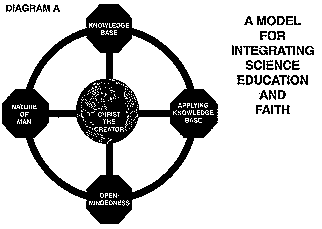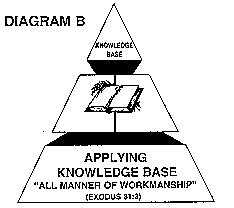One of the four Master's degree programs at the Institute for Creation Research leads to a degree in science education. Science education is a broad amorphous field of study with little agreement among the experts as to exactly what comprises the field. Because of its diverse nature, it is important that a science education student be able to integrate ideas, concepts, and principles from many different disciplines. For example, a person trained as a secondary biology teacher should also take courses in chemistry and physics. Yet the educational literature shows that course work in a discipline (such as chemistry or physics) does not usually enable the student to integrate and apply that knowledge to other disciplines. Thus training Master's level educators in principles of integration is of vital importance.
Integration can be defined in many ways. In dealing with science education and faith issues, integration can be defined as putting them together into a synthetic whole under a Biblical umbrella. Because the study of science and origins is multidisciplinary in nature, this suggested process of integration allows for the blending together of ideas from many different scientific disciplines. This encourages thinking to expand beyond the narrow focus found in many of today's science disciplines. Because God did not create the world in a compartmentalized fashion, one must have at least some knowledge in many disciplines in order to synthesize the big picture of the world.
In order for individuals to obtain the ability to accomplish this type of higher order thinking, some basic guidelines are needed. Among these are: (1) a model which guides thinking in terms of integration; (2) knowledge of what should be integrated; (3) time to practice the application of the ideas, concepts, and principles that are to be integrated; and (4) most importantly, a personal relationship with the Creator, Jesus Christ. In reference to point number one, the writer proposes the following model as a basis for integration. As students progress through a particular course in science education, they should use the model to help integrate the concepts and principles being studied. This process is described below.
The model components provide a framework for a graduate school science education learning environment and setting. Communication and learning-problem areas can be addressed and identified, using the model as a base. The components of the model deal with the issue of the source of knowledge and how it is obtained. The four components are centered around a creationist world view which focuses on the Creator, Jesus Christ. When the mind is set on Jesus Christ as the Creator and Author of all truth, false traditions of man fade into the background, and one tries to live according to the principles of Christ (Acts 17:22-31; I Thessalonians 5:21; and II Corinthians 10:4,5). The need for this approach grows out of the fact that the five commonly relied upon sources of knowledge—experience, authority, deductive reasoning, inductive reasoning, and the scientific approach—all have limitations and deficiencies, whereas, the creationist world view is based upon a foundation which is truth. That foundation is the person of Jesus Christ, who is the truth (John 14:6). A person's world view is the core which impacts his life and influences it in four key areas.

World view: The presuppositions, orientations, and beliefs that act as a filter or screen through which to interpret life. The basis for the central core of our model is a world view based on the ICR Tenets of Scientific and Biblical Creationism. The other four components of the model (see Diagram A) flow out of this Biblical Creationist view and perspective. The four world-view components of the model are listed and discussed below.
Nature of man: Personality, character, motivational traits, spiritual maturity, as well as developmental levels of the learner that influence learning. Our model focuses on the learner's present characteristics as well as who he or she is in Jesus Christ the Creator. This also entails a vision for the eternal state which goes beyond the present characteristics of mankind. A comprehensive secular account of how the "nature of man" component affects learning and instruction in the area of science education has already been developed. Jean Piaget's four widely used cognitive developmental stages have been applied extensively in development of secular science education curricula. However, much of the account of the nature of man found in the secular journals is based on a false world view which portrays man as a product of evolutionary processes. This view sees man as the one in charge of his own destiny and not in need of a personal savior. This is the opposite of the creationist world view which depicts man as a sinner and in need of a redeemer. Therefore, it is incumbent upon the users of a creationist model to sharpen their abilities to integrate Scripture with the principles learned in science education.
Receptivity: Openness or resistance to change (e.g., to new people, information, and settings). Many people, because of past hurts, traumas, and other problems, are not open to change and the risk of possible failure. Some professional people are not willing to change the ideas with which they were indoctrinated during their college experience. They have been taught the secular evolutionary perspective and have not taken time to think through the implications of such teachings. This attitude inhibits learning. The writer's model helps to identify the presence of these factors in learning and to restore full receptivity to a world view based on the truth which is found in the person of Jesus Christ. In order to restore a person to full receptivity of a creationist world view, one must help the person restore his/her personal relationship to the Creator to its highest possible level; for it is the broken relationship with the Creator which moves us away from truth. This is because Jesus Christ is truth and only by knowing Him can one really know the truth. Paul stated this principle well in Colossians: "Whom we preach warning every man and teaching every man in all wisdom: that we may present every man complete in Christ Jesus" (Colossians 1:28).
Knowledge: Prerequisite or prior learning and its relationship to content about to be learned. This model focuses on how to link what is to be learned with what has already been learned. This is a Scriptural approach to gaining new knowledge as stated by Isaiah, 'For precept must be upon precept, precept upon precept; line upon line, line upon line; here a little, and there a little" (Isaiah 28:10). This gradual process allows one to move toward being "filled with the spirit of God, in wisdom, and in understanding, and in knowledge, and in all manner of workmanship" (Exodus 31:3).
It is understood that the scientifically literate person needs more than just a base of knowledge. The specific knowledge that a person acquires should be available to be used in everyday life. In educational circles, this is known as "general transfer" which involves the process of being able to apply acquired knowledge to a specific problem or situation. From the creationist perspective this requires filtering the knowledge base through a Biblical framework and applying it (see Diagram B).
Application: Putting into practice what has already been learned (one's knowledge base). Application of learning in real life situations makes learning meaningful, relevant, retainable, and more transferable. The study of the disciplines of science education leads to numerous practical ways of applying knowledge to life's situations and problems. By learning how to apply what has been learned, the graduate student in science education should leave ICR (or any similar Christian graduate program in science education) as a fully prepared professional.
 As the model depicts, the four components are not viewed as static entities. There is a dynamic interaction between and among these components that makes science education endeavors an ongoing process of adjustments and refinements. These dynamics are incorporated into teaching from the perspective of the model.
As the model depicts, the four components are not viewed as static entities. There is a dynamic interaction between and among these components that makes science education endeavors an ongoing process of adjustments and refinements. These dynamics are incorporated into teaching from the perspective of the model.
After students complete this program, the world view which they have developed will be carried on to the people whom they disciple. People do not forget what has been made real to them and has an application to their lives. When one is educated according to the components of this model, knowledge will be based on truth. New learning will become a part of the student and will have eternal well as practical benefits. The student will be equipped to address professional problems from a valid, Biblical Creationist based framework rather than just being equipped to repeat answers learned in past course work.
Ary, Donald. Introduction to Educational Research. Holt, Rinehart, and Winston, 1990.
Beck, David W., Opening the American Mind: The Integration of Biblical Truth in the Curriculum of the University. Baker Book House, 1991.
Byrne, H. W., A Christian Approach to Education. Mott Media, 1977.
Kienel, Paul A., The Philosophy of Christian School Education. ACSI, 1978.
Morris, Henry M., Christian Education for the Real World Master Books. 1991.
Gallagher, James I., "Prospective and Practicing Secondary School Science Teachers' Knowledge and Beliefs About the Philosophy of Science." Science Education 75 (1) :121-133 (1991).
* Dr. Deckard is assistant Professor of Science Education in the ICR Graduate School.



